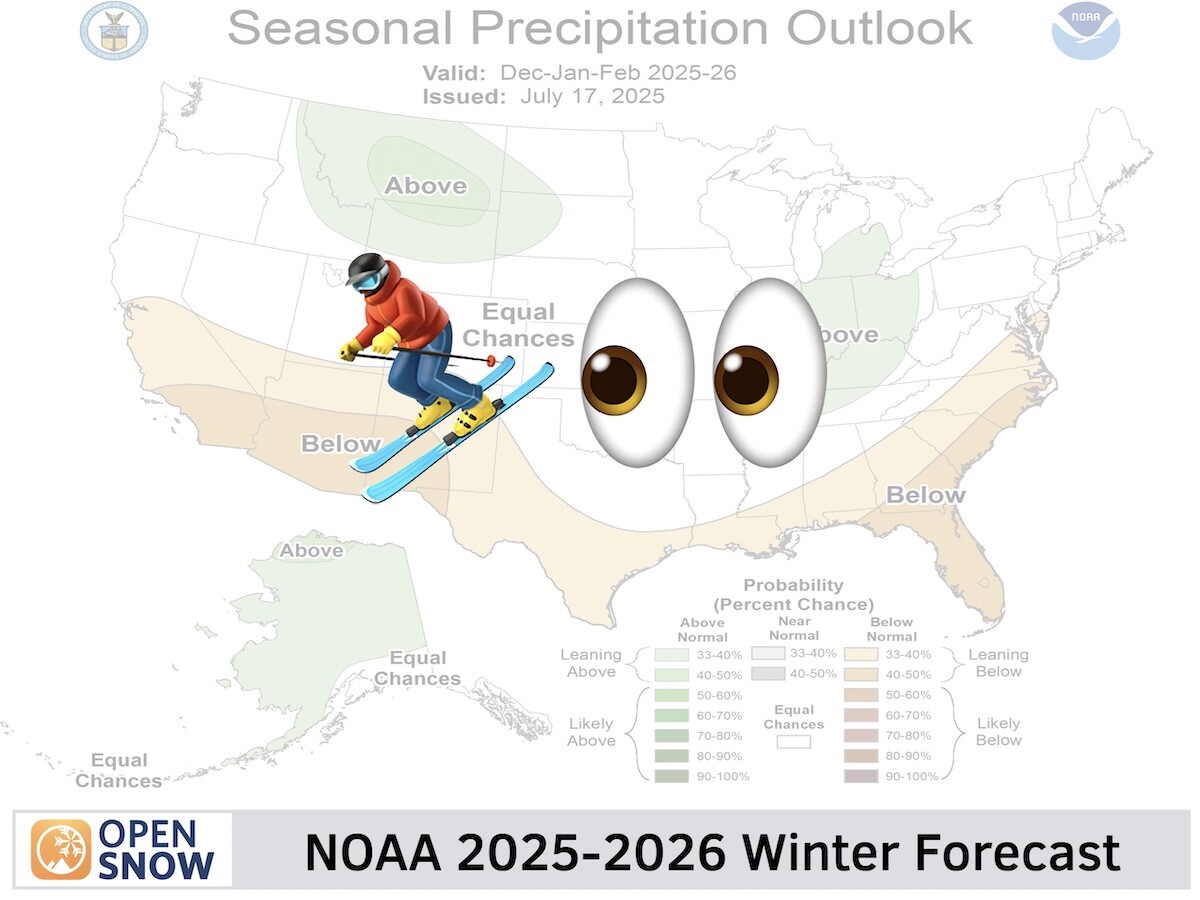News

By Zach Butler, Meteorologist Posted 9 months ago October 16, 2024
2024-2025 Mid-Atlantic Winter Forecast Preview

For the upcoming 2024-2025 winter season, La Niña conditions are growing and are favored to emerge during the late fall. Before getting into the details of what that could mean for the Mid-Atlantic, it's important to remember that any winter outlook will contain an inherent degree of uncertainty.
Long-range forecasts are rarely accurate. These forecasts cover 3-6 months but we know that skiing quality improves and degrades with storm cycles that last a few days to a week.
La Niña, Explained
The term La Niña refers to the large-scale ocean-atmosphere climate phenomenon linked to periodic cooling in sea-surface temperatures across the central and east-central equatorial Pacific.
La Niña represents the cool phase of the ENSO cycle and means that the ocean water temperatures are cooler than average.
Ski Season Snowfall vs. La Niña
The map below shows winter snowfall during seven La Niña episodes. The lower the number, the stronger the La Niña. The blue dots are above average, the white dots are average, and the orange dots are below average snowfall.

"ENSO Neutral" conditions (neither La Niña nor El Niño) have persisted through the summer of 2024 and long-range models have been projecting a higher-than-average chance of a La Niña taking over during the winter of 2024-2025.
The weekly Nino-3.4 region index (sea surface temperatures in the east-central Pacific) anomaly has dropped from 1.8°C during the 2023-2024 winter season to -0.1°C as of September 9, 2024.
A similar change from El Niño to a weak La Niña last occurred ahead of the 2016-2017 winter season.
Thanks to my colleague Alan Smith, we have identified six winters since 1990 in which weak La Niña conditions were present:
- 2000-2001
- 2005-2006
- 2008-2009
- 2016-2017
- 2017-2018
- 2022-2023
We will use these winter seasons that featured a weak La Niña as “analog” years for this analysis.
The following weather stations in this article have a mixed period of record and are not located at resorts, but are the best data available for different areas in the Mid-Atlantic. They provide a quick look at snowfall trends for different areas in the Mid-Atlantic based on weak La Niña years.
Historical Weak La Niña Seasons in the Catskills

After looking back at the six weak La Niña winters and comparing them against the 30-year median season snowfall of 51.5 inches at the Mohonk Lake, New York weather station. I've found that the median season snowfall at this location (just south of the Catskills) during those years is 55.4 inches or 108% compared to the 30-year normal.
Season Snowfall During La Niña
- 1991-2020: 51.5" (30-year normal)
- 2000-2001: 101.0" (196%)
- 2005-2006: 51.5" (100%)
- 2008-2009: 47.2" (92%)
- 2016-2017: 68.8" (134%)
- 2017-2018: 59.3" (115%)
- 2022-2023: 44.0" (86%)
Three out of the six La Niña years produced well above-normal snowfall, two produced near-normal snowfall, and one produced well below-normal snowfall.
This shows that it is more common to have an above-normal snow season near and around the Catskills during weak La Niña years.
Historical Weak La Niña Seasons in Western New York
After looking back at the six weak La Niña winters and comparing them against the 30-year median season snowfall of 107.0 inches at the Franklinville, NY weather station (near Holiday Valley). I've found that the median season snowfall at this location during those years is 107.8 inches or 101% compared to the 30-year normal.
Season Snowfall During La Niña
- 1991-2020: 107.0" (30-year normal)
- 2000-2001: 107.0" (100%)
- 2005-2006: 99.1" (93%)
- 2008-2009: 138.2" (129%)
- 2016-2017: 108.5" (101%)
- 2017-2018: 117.5" (110%)
- 2022-2023: 49.0" (46%)
Two out of the six La Niña years produced well above-normal snowfall, three produced near-normal snowfall, and one produced well below-normal snowfall.
This shows that it is more common to have an above-normal to a normal snow season near and around Western New York during weak La Niña years.
Historical Weak La Niña Seasons in Central Pennsylvania
After looking back at the six weak La Niña winters and comparing them against the 30-year median season snowfall of 32.4 inches at the Williamsport Regional Airport, PA weather station. I've found that the median season snowfall at this location during those years is 23.5 inches or 73% compared to the 30-year normal.
Season Snowfall During La Niña
- 1991-2020: 32.4" (30-year normal)
- 2000-2001: 37.8" (117%)
- 2005-2006: 22.8" (70%)
- 2008-2009: 24.2" (75%)
- 2016-2017: 41.1" (127%)
- 2017-2018: 21.6 (67%)
- 2022-2023: 19.9 (61%)
Two out of the six La Niña years produced well above-normal snowfall and four produced well below-normal snowfall.
This shows that it is more common to have a below-normal snow season near and around Central Pennsylvania during weak La Niña years.
Historical Weak La Niña Seasons in West Virginia

After looking back at the six weak La Niña winters and comparing them against the 30-year median season snowfall of 50.3 inches at the Bartow, WV weather station (near Snowshoe). I've found that the median season snowfall at this location during those years is 50.5 inches or ~100% compared to the 30-year normal.
Season Snowfall During La Niña
- 1991-2020: 50.3" (30-year normal)
- 2000-2001: 50.6" (101%)
- 2005-2006: 65.5" (130%)
- 2008-2009: 50.3" (100%)
- 2016-2017: 37.1" (74%)
- 2017-2018: 67.6" (134%)
- 2022-2023: 13.3" (26%)
Two out of the six La Niña years produced well above-normal snowfall, two produced near-normal snowfall, and two produced well below-normal snowfall.
This shows that weak La Niña years have strong variability in West Virginia with equal chances of above-normal, normal, and a below-normal snow season.
Historical Weak La Niña Seasons in North Carolina
After looking back at the six weak La Niña winters and comparing them against the 30-year median season snowfall of 55.4 inches at the Mt. Mitchel weather station. I've found that the median season snowfall at this location during those years is 65.1 inches or 117% compared to the 30-year normal.
Season Snowfall During La Niña
1991-2020: 55.4" (30-year normal)
2000-2001: 90.1" (163%)
2005-2006: 63.1" (114%)
2008-2009: 67.0" (121%)
2016-2017: 55.4" (100%)
2017-2018: 85.9 (155%)
2022-2023: 25.1 (45%)
Four out of the six La Niña years produced well above-normal snowfall, one produced normal snowfall, and one produced well below-normal snowfall.
This shows that it is more common to have a above-normal snow season near and around the Smoky Mountains in North Carolina.
Temperatures During Weak La Niña Winters
While snowfall is what we pay attention to the most during ski season, temperatures are especially important in the Mid-Atlantic where they impact the rain-snow line.
I examined NOAA’s, National Center for Environmental Information (NECI) Climate Division dataset, which takes in station observations throughout the United States. A look at the NOAA/NECI map below for the La Niña winters analyzed above shows normal to slightly above-normal temperatures for all of the Mid-Atlantic from November through March.

2016-2017 Winter Season
As mentioned above, the Niño-3.4 region index anomaly as of September 9, 2024, is down to -0.1°C, which is similar to where it was ahead of a La Niña event during the summer of 2016.
Since this last occurred back in 2016, let's have a little fun by looking back at the snowfall during the 2016-2017 winter season for Snowshoe in West Virginia.
Data courtesy of BestSnow.net:
It was not a good winter during the 2016-2017 winter but as mentioned earlier, West Virginia's snowfall data shows a lot of variability between above, normal, and below-normal snowfall during weak La Niña's.
Overall, history tells us that Mid-Atlantic tends to see variable snowfall during weak La Niña winters, with a slight favorability for above-normal snowfall for northern locations and below-normal snowfall for southern locations.
- This variability comes from a few below-normal snowfall and a few above-normal snowfall winters during the six similar weak La Niña episodes.
La Niña and Nor'easters
La Niña has a strong influence on the weather pattern across North America. During La Niña, storm systems track through the Pacific Northwest and the central US. This can bring storms into a favorable area of developing into Nor'easters, which can move up the East Coast and bring heavy snow.
- La Niña can favor Nor'easters slightly, which brings the possibility of heavy snow
- Nor'easters are notorious for having a sharp rain-snow line and a sharp light-to-heavy snow zone
- This adds complication to whether a given area will see more snow or not from Nor'easters during La Niña

Having said all of this, for skiers and snowboarders, keep in mind that when it comes to finding the best conditions, it’s all about timing. To have the best chance of enjoying the deepest powder, our recommendation is to dial in your plans 7-10 days in advance.
Sometimes, longer-range forecasts can identify possible storms 1-2 weeks (or longer) in advance, but often, forecast confidence in the details of each storm only begins to increase when the system is about one week away or closer.
Upgrade to OpenSnow All-Access for 10-day snow forecasts, expert local analysis, and custom snow alerts to help you find the deepest snow and the best ski conditions all winter long.

Every OpenSnow All-Access subscription is also good for 365 days.
- 10-Day Snow Forecasts
- Expert Local Forecasters
- Custom Snow Alerts
- 3D Snowfall Maps
- Snow Forecast & Report Widgets
- 10-Day Hourly Forecasts
- Current & Forecast Radar
- Active Fire & Smoke Maps
- Lightning Risk Forecasts
- Offline Satellite & Terrain Maps
"The OpenSnow app is an absolute must-have for anyone who loves winter sports or simply wants to stay informed about snow conditions. The interface is user-friendly, making it easy to access detailed weather forecasts, snow reports, and mountain updates. The accuracy of the predictions is impressive, giving me confidence in planning my ski trips." – August 2024 Review
Questions? Send an email to [email protected] and we'll respond within 24 hours. You can also visit our Support Center to view frequently asked questions and feature guides.
Zach Butler
About The Author




